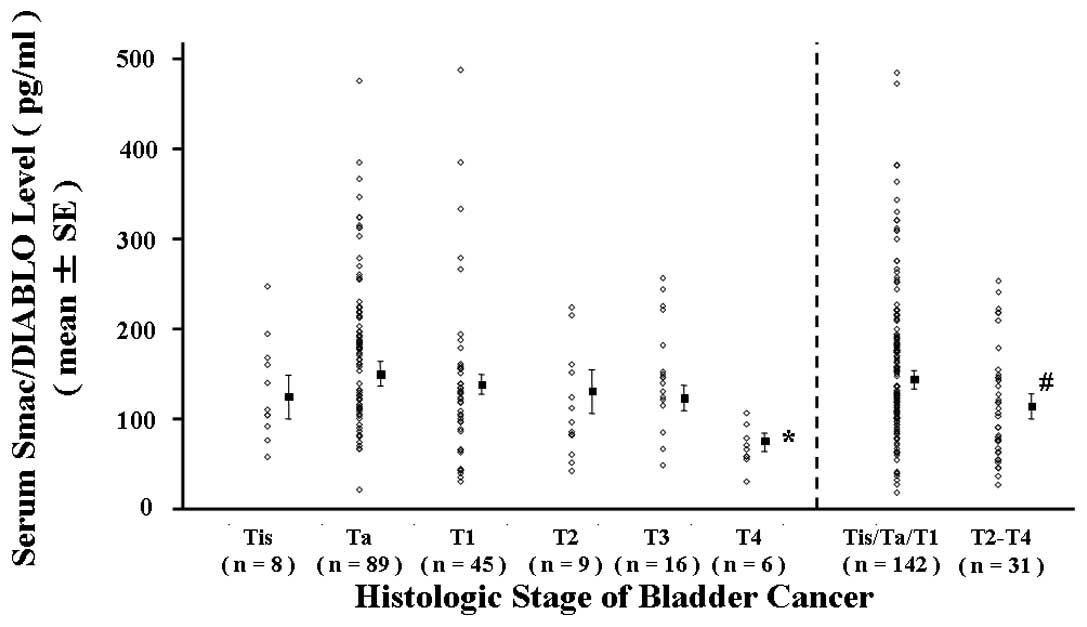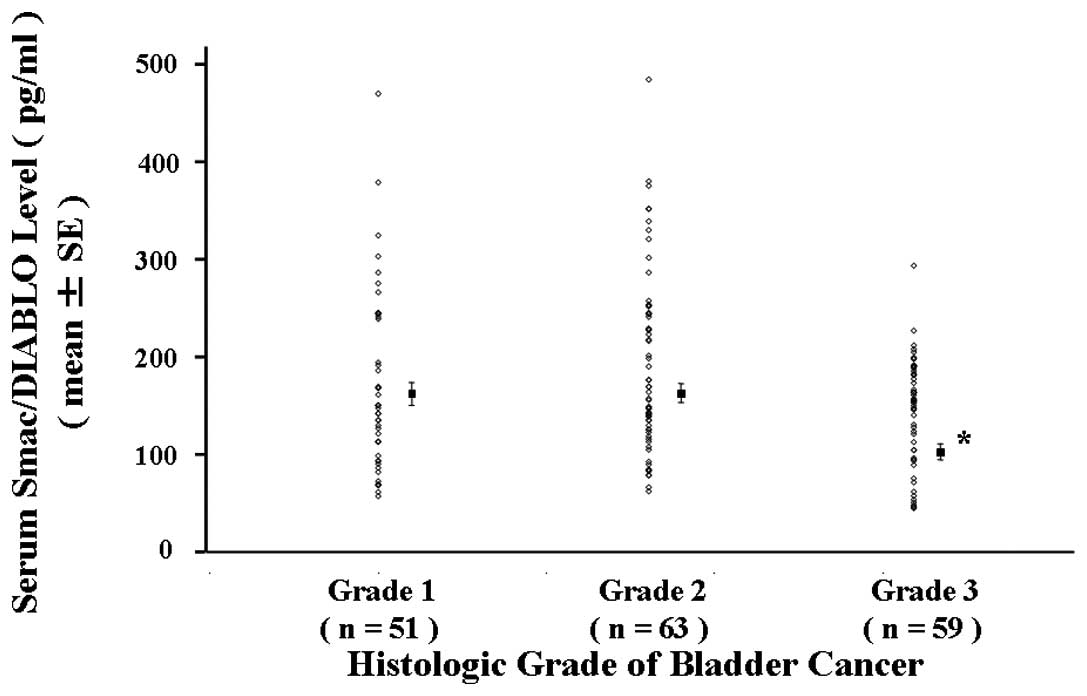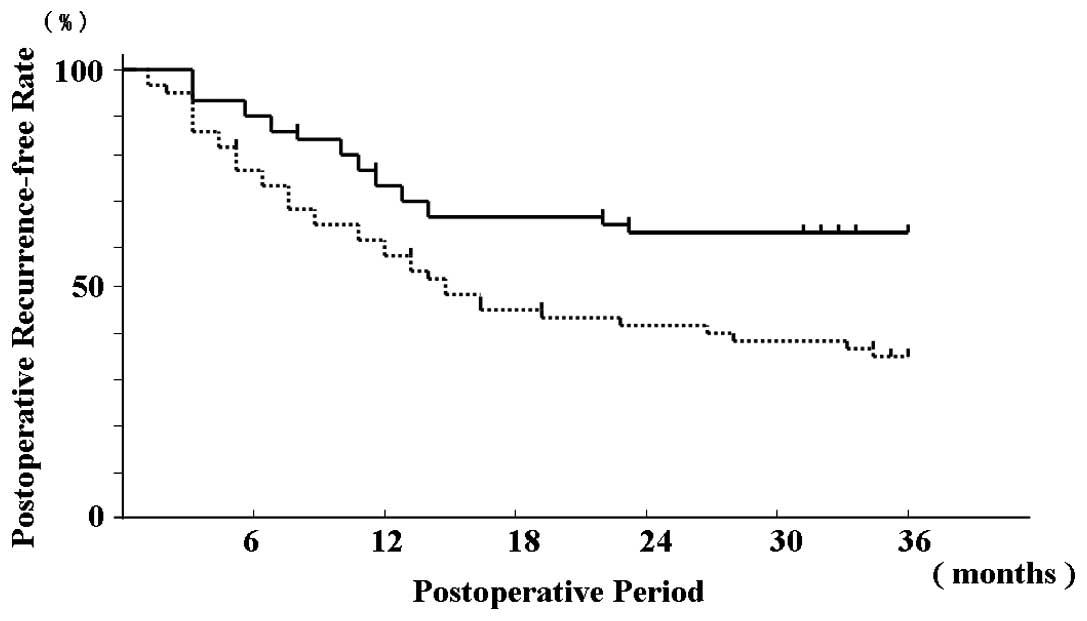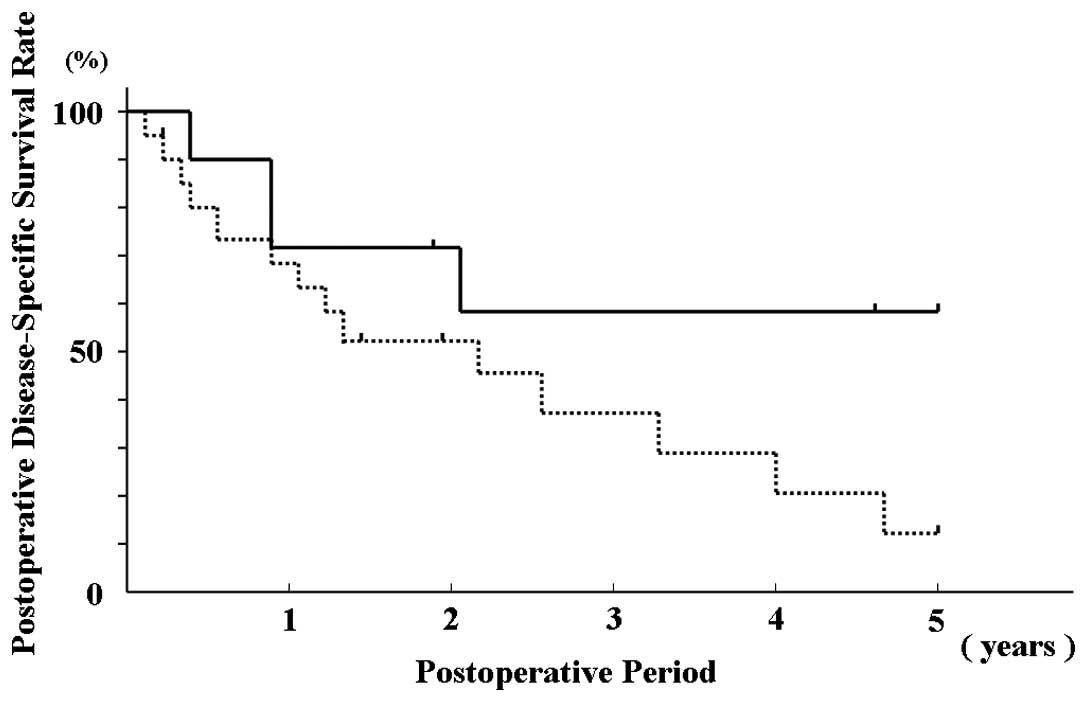Introduction
Bladder cancer accounts for ~4% of all cancers
worldwide. Clinical factors have been used historically as
prognostic or predictive markers such as stage and grade of bladder
cancer. Recent advances have been achieved to unravel both the
pathogenesis and molecular biology of bladder cancer with the
objective of developing new methods for early diagnosis and better
prognosis for patients with bladder cancer (1). Although many factors have been
reported, a few maintained independent significance in terms of
overall survival (2). In addition,
several reported results have been controversial by studying the
same biomarker. Therefore, it is necessary to identify new reliable
diagnostic and prognostic markers in bladder cancer.
Cancer cells respond to cytotoxic therapies by
activation of the type II mitochondrial apoptotic pathway. The
activation of this pathway results in the depolarization of the
mitochondrial membrane potential and the release from the
mitochondria into the cytosol both cytochrome c and second
mitochondria-derived activator of caspase/direct inhibitor of
apoptosis protein (IAP)-binding protein with low pl (Smac/DIABLO).
These lead to the activation of caspases 3, 8 and 9 and apoptosis
(3). Smac has been identified as a
protein that stimulates the activation of caspase 3 in cell
extracts (4). DIABLO has been
identified independently and has been shown to be the same molecule
as Smac and hence, it has been term Smac/DIABLO (5). Smac/DIABLO is expressed in most adult
human tissues at different levels. It is synthesized in the nucleus
as a precursor protein of 239 amino acid residues and an amino
terminal mitochondrial leader sequence (MLS). Upon mitochondrial
import, the MLS is removed by proteolysis, exposing the IAP-binding
motif (IBM) at the N-terminus of the mature Smac/DIABLO and which
is present as dimers. Through this IBM, Smac/DIABLO can bind IAP
family members including X-linked IAP (XIAP), cIAP-1 and cIAP-2 and
survivin. One way by which Smac/DIABLO promotes the activation of
caspases is by displacing caspase 9 that is coupled with XIAP
(3). The inhibitory function of
Smac/DIABLO relies on IBM. Thus, Smac/DIABLO functions by
inhibiting the IAPs; hence, Smac/DIABLO is considered as an
apoptogenic factor.
Previous studies have reported that overexpression
of Smac/DIABLO sensitizes the resistant cancer cells to death
receptor- or anticancer cytotoxic agent-induced apoptosis (6,7).
These findings suggested that Smac/DIABLO plays an important role
in the regulation of apoptotic responses in cancer cells to both
immune- and drug-mediated treatments. Several studies examined the
expression of Smac/DIABLO in various cancers and normal tissues
(8,9). However, whether Smac/DIABLO is
released into the circulation and present in the serum of normal
and cancer patients has not been examined. We have reported that
the expression of Smac/DIABLO in patients with bladder cancer, as
examined by Western blotting, is diminished (9). Further, the low level of Smac/DIABLO
expression was proposed to be a prognostic factor. The present
study investigated the following: 1) Whether Smac/DIABLO is
detected in the serum of normal and cancer patients. 2) Whether the
serum level of Smac/DIABLO decrease in patients with bladder cancer
compared to normal healthy individuals. 3) Whether the level of
Smac/DIABLO correlate with both the stage and grade of bladder
cancer, and 4) whether the serum level of Smac/DIABLO predict tumor
recurrence.
Materials and methods
Patients
Peripheral blood was obtained from 173 patients with
initial primary bladder cancer before surgery or anticancer
therapy. They included 140 male and 33 female patients, ranging in
age from 24 to 89 years. Histologic diagnosis revealed that all
patients had urothelial carcinoma of bladder cancer. Their
histologic classification and staging according to the TNM
classification were: Tis (n=8), Ta (n=89), T1 (n=45), T2 (n=9), T3
(n=16), T4 (n=6), and G1 (n=51), G2 (n=63), G3 (n=59),
respectively. The cases had no metastasis.
The patients had no treatments for bladder cancer
before surgery. Patients with Ta and T1 non-muscle invasive bladder
cancer were not treated after transurethral resection of bladder
tumor (TUR-Bt) until recurrence. When patients with muscle-invasive
bladder cancer had recurrence or metastasis after radical
cystectomy, they were treated with cisplatin-based
chemotherapy.
Blood samples were also collected from 36 healthy
donors without malignancy based on the medical history. This study
was performed after approval by a local Human Investigations
Committee. Informed consent was obtained from each normal and
cancer patient.
The sera were separated by centrifugation of the
blood after collection, and stored frozen at −80°C until future use
for an enzyme-linked immunosorbent assay (ELISA).
ELISA for Smac/DIABLO
The levels of Smac/DIABLO in the sera were
quantitated by the sandwich ELISA according to the manufacturer’s
protocol (Assay Designs Inc., Ann Arbor, MI, USA). The serum
concentrations of Smac/DIABLO were calibrated from a dose response
curve based on reference standards. This method made it possible to
estimate serum Smac/DIABLO levels >7.81 pg/ml. Repeated
measurements yielded the same results.
Patients were divided into two groups according to
the level of Smac/DIABLO in the serum. The level of serum
Smac/DIABLO greater than the mean value was regarded as ‘high
level’ and the level less than the mean value was regarded as ‘low
level’.
Statistical analysis
All determinations were made in triplicate. For
statistical analysis, Student’s t-test was used. Postoperative
tumor-free interval and postoperative disease-specific survival
rate was determined by the Kaplan-Meier method. The Cox-Mantel test
was used to establish the statistical difference in tumor-free
period and disease-specific survival rate between the patients with
high and low serum Smac/DIABLO levels. P<0.05 was considered
significant.
Results
Circulating Smac/DIABLO levels in the
sera of normal individuals and patients with bladder cancer
The serum levels of Smac/DIABLO in samples derived
from normal healthy controls and patients with all histological
stages of bladder cancer were determined by ELISA. The mean serum
levels of Smac/DIABLO in normal individuals and patients were 257
and 136 pg/ml, respectively (Fig.
1). In comparison with the serum level of healthy individuals,
there was an approximately 2-fold decrease in serum Smac/DIABLO
level in patients with bladder cancer.
The serum level of Smac/DIABLO in
patients with bladder cancer
We examined the serum levels of Smac/DIABLO in
patients with bladder cancer as a function of their histologic
stages and grades of the disease. The mean serum level of
Smac/DIABLO was significantly lower (P<0.05) in patients with
muscle-invasive bladder cancer (T2–T4N0M0) than that in patients
with non-muscle invasive cancer (Tis, Ta, T1N0M0) (Fig. 2). Furthermore, the mean serum level
of Smac/DIABLO in patients with T4 bladder cancer was significantly
lower (P<0.05) than that in patients with T2–T3 cancer. The mean
serum level of Smac/DIABLO in patients with Grade 3 bladder cancer
was significantly lower (P<0.05) than that in patients with
Grade 1 and Grade 2 cancers (Fig.
3).
These findings demonstrate that analyses based on
the histological stage and grade of bladder cancer revealed a
tendency for decrease in the serum level of Smac/DIABLO as a
function of disease progression and a higher grade.
Relationship between the mean serum level
of Smac/DIABLO and the postoperative tumor-free period in patients
with Ta and T1 non-muscle invasive bladder cancer
Ta and T1 non-muscle invasive bladder cancer
patients undergoing TUR-Bt were retrospectively evaluated for the
postoperative clinical course. The postoperative tumor-free period
was estimated by Kaplan-Meier analysis. Based on the analysis,
patients with non-muscle invasive bladder cancer were divided into
two groups, namely, those with high level of serum Smac/DIABLO
(greater than the mean value) and those with low level of serum
Smac/DIABLO (less than the mean value). Patients with Ta and T1
bladder cancer with high level of serum Smac/DIABLO showed a
significantly longer postoperative tumor-free period as compared to
those with low level in the 3-year follow-up (P<0.05) (Fig. 4). These results suggest that the
level of serum Smac/DIABLO may be a significant prognostic
parameter in patients with Ta and T1 bladder cancer.
Relationship between the mean serum level
of Smac/DIABLO and the postoperative clinical course in patients
with T2–T4 muscle-invasive bladder cancer
T2–T4 (N0M0) muscle-invasive bladder cancer patients
undergoing radical cystectomy were also retrospectively evaluated
for the postoperative clinical course. Based on the analysis,
patients with muscle-invasive bladder cancer were divided into two
groups, namely, those with high level of serum Smac/DIABLO (greater
than the mean value) and those with low level of serum Smac/DIABLO
(less than the mean value). Patients with muscle-invasive bladder
cancer with high level of serum Smac/DIABLO showed a higher
disease-specific survival rate as compared to those with low level
in the 5-year follow-up (P<0.05) (Fig. 5). These results suggest that the
level of Smac/DIABLO may be a significant prognostic indicator in
patients with muscle-invasive bladder cancer as well as non-muscle
invasive bladder cancer; and that high level of serum Smac/DIABLO
may be considered a good prognostic sign.
Discussion
The present study demonstrates for the first time
that Smac/DIABLO can be detected in the serum. Further, we
investigated whether the serum level of Smac/DIABLO in patients
with bladder cancer was modified as a function of both the stage
and the grade of the disease. We report that the mean level of
serum Smac/DIABLO in patients with bladder cancer was significantly
lower than that in normal volunteers, and that the mean serum level
of Smac/DIABLO inversely correlated both with the progression of
the stage and the increase of the grade of bladder cancer. To our
knowledge, this study is the first to show that patients with Ta
and T1 non-muscle invasive bladder cancer patients with high serum
level of Smac/DIABLO had a longer tumor-free interval than those
with low level in the 3-year follow-up. In addition, patients with
muscle-invasive bladder cancer with high serum level of Smac/DIABLO
had a higher disease-specific survival rate than those with low
level in the 5-year follow-up. Although we report a small number of
patients during a short-term follow-up in this study, our
preliminary data indicate that the level of serum Smac/DIABLO may
be one of the significant prognostic parameters in patients with
bladder cancer.
There are many reported studies on the expression of
Smac/DIABLO in both normal and cancer tissues (8,9).
However, there have been no reports on the serum levels of
Smac/DIABLO in either normal donors or cancer patients. Our
previous study, using Western blot analysis, revealed that ~24% of
patients with bladder cancer had no detectable Smac/DIABLO
expression, although all normal bladder specimens expressed
Smac/DIABLO. In addition, advanced high grade diseases had lower
expression of Smac/DIABLO than those with low stage/grade diseases.
Further, our previous study and those of others showed that normal
kidney tissues adjacent to the cancer showed higher levels of
Smac/DIABLO expression when compared to cancer tissues, and that
the progression of renal cell carcinoma was associated with low
level of Smac/DIABLO expression (8,10).
Similar results were obtained in other cancers including colorectal
cancer and lung cancer (11,12).
Overall, our studies and those of others demonstrate that the
expression level of Smac/DIABLO in cancer tissues is significantly
lower compared with the corresponding non-cancerous tissues and
correlate with cancer progression. Thus, we have stipulated that
serum levels of Smac/DIABLO might have been reflective of the
levels of Smac/DIABLO expression in cancer tissues.
The current study demonstrates for the first time
that the serum level of Smac/DIABLO predicted the clinical outcome
and that the high level in the serum was a good prognostic sign in
patients with bladder cancer. The precise underlying mechanism
responsible for this relationship remains unclear. Since
Smac/DIABLO is a proapoptotic regulatory molecule, it is reasonable
to assume that the elevated levels of Smac/DIABLO in the
circulation might have resulted from its release following
apoptosis of cells. In contrast, the low serum levels of
Smac/DIABLO in the serum may reflect tumor escape from
apoptosis.
The precise cellular origin of Smac/DIABLO has not
been elucidated. We speculate that Smac/DIABLO may be derived from
cancer cells and/or normal tissues. Previous studies demonstrated
that Smac/DIABLO was expressed by various cancers (8–12).
Normal tissues including lung, heart, liver, spleen, pancreas,
kidney, prostate, testis and ovary also highly express Smac/DIABLO
(4,5). Preliminary experiments showed that
Smac/DIABLO was detected in the culture supernatants of bladder
cancer cell lines and primary cultures derived from surgical
specimens examined. These findings suggest that Smac/DIABLO may be
produced by both cancer cells and normal tissues. In addition,
bladder cancer cells may secrete several factors that regulate
Smac/DIABLO production. Further studies are needed to determine the
origin of Smac/DIABLO.
Smac/DIABLO is not a secretory molecule. It is
possible that its presence in the circulation may be due to the
physiological cell death of normal tissues and cell death of cancer
cells. Based on our findings, the circulating levels of Smac/DIABLO
in bladder cancer patients on the average are lower than those
detected in normal healthy individuals presumably due to a
disturbance in the turnover rate of Smac/DIABLO in cancer patients.
However, our findings in normal individuals revealed that there was
a significant subpopulation of individuals who had levels of
Smac/DIABLO in the same range as bladder cancer patients. This may
be interpreted that such individuals might have a distinct turnover
rate and/or possibly that Smac/DIABLO is degraded and modified and
not detected by the ELISA assay used.
Preliminary experiments demonstrate that the level
of Smac/DIABLO in the serum derived prior to surgery increased
after curative surgery in patients with muscle-invasive bladder
cancer (data not shown). However, in patients with non-muscle
invasive bladder cancer, the mean serum level of Smac/DIABLO
derived before surgery did not change after TUR-Bt. Since
Smac/DIABLO is a proapoptotic regulatory molecule, it is reasonable
to assume that elevated level of Smac/DIABLO in the circulation may
contribute to induce apoptosis in muscle-invasive bladder cancer
through its ability to inhibit IAP family members. Therefore, low
level of Smac/DIABLO in the serum may be a novel mechanism of tumor
cells’ escape from apoptosis in muscle-invasive bladder cancer. If
these were the case, the present findings suggest that Smac/DIABLO
mimetics may provide a therapeutic means of preventing the growth
of muscle-invasive bladder cancer.
IAPs such as XIAP are highly expressed in various
cancers and are associated with poor prognosis and resistance to
apoptosis (13,14). Our previous report demonstrated
that elevated expression of XIAP was found in high stage and high
grade bladder cancers (15). Since
XIAP blocks apoptosis at the effector phase, strategies targeting
XIAP as well as Smac/DIABLO may be effective to overcome resistance
to apoptosis. Smac/DIABLO is able to bind to IAP family members and
XIAP is predominantly a Smac/DIABLO-binding protein. Smac/DIABLO
binds to XIAP, displaces XIAP from caspase-9, promotes cleavage of
effector caspases and induces apoptosis (16,17).
In addition, Smac/DIABLO is also regulated by IAP family members.
IAP family members including XIAP induce the ubiquitination and
degradation of Smac/DIABLO (18,19).
Our findings correlating the levels of Smac/DIABLO
decreasing as a function of stage and grade of disease might be
interpreted by at least two possibilities. The first is that the
more aggressive the tumor, the less apoptotic cell death takes
place and less Smac/DIABLO is released in the circulation.
Alternatively, we have reported that the level of XIAP varies as a
function of disease progression, since XIAP induces ubiquitation
and degradation of Smac/DIABLO, the more XIAP level in the cell the
less Smac/DIABLO will be available and detected in the serum.
Furthermore, Smac 3, a Smac/DIABLO isoform, was recently identified
(20). Smac 3 induces
autoubiquitination and degradation of XIAP. Thus, its low ratio
between IAP family members and Smac/DIABLO may be important in
favor of the response to cytotoxic therapy. Further studies are
therefore needed to determine the regulatory effects of Smac/DIABLO
production in bladder cancers. The measurement of IAP family as
well as Smac/DIABLO in the serum may be necessary for the accurate
evaluation of the prognostic value of Smac/DIABLO and the efficacy
of therapy with Smac/DIABLO mimetics.
In conclusion, the data presented in this
communication have demonstrated that Smac/DIABLO can be detected in
the sera of both normal and cancer patients. The levels of
Smac/DIABLO in patients with bladder cancer inversely correlated
with histologic stage and grade of the disease; and low serum
levels of Smac/DIABLO were associated with early recurrence in
patients with bladder cancer. The correlation between the level of
serum Smac/DIABLO and postoperative prognosis suggests that the
serum level Smac/DIABLO could be used as a prognostic marker in
patients with bladder cancer. The accurate prediction of prognosis
may help select patients for more intensive surgical or
chemotherapeutic approaches in combination with Smac/DIABLO
agonists.
Abbreviations:
|
ELISA
|
enzyme-linked immunosorbent assay
|
|
IAP
|
inhibitor of apoptosis protein
|
|
IBM
|
IAP-binding motif
|
|
MLS
|
mitochondrial leader sequence
|
|
Smac/DIABLO
|
Second mitochondria-derived activator
of caspase/Direct inhibitor of apoptosis protein-binding protein
with low pl
|
|
TUR-Bt
|
transurethral resection of bladder
tumor
|
|
XIAP
|
X-linked inhibitor of apoptosis
protein
|
References
|
1
|
Grossman HB, Soloway M and Messing E:
Surveillance for recurrent bladder cancer using a point-of-care
proteomic assay. JAMA. 295:299–305. 2007. View Article : Google Scholar : PubMed/NCBI
|
|
2
|
Bajorin DF, Dodd PM and Mazumdar M:
Long-term survival in metastatic transitional-cell carcinoma and
prognostic factors predicting outcome of therapy. J Clin Oncol.
17:3173–3181. 1999.PubMed/NCBI
|
|
3
|
Srinivasula SM, Datta P, Fan XJ,
Fernandes-Alnemri T, Huang Z and Alnemri ES: Molecular determinants
of the caspase-promoting activity of Smac/DIABLO and its role in
the death receptor pathway. J Biol Chem. 275:36152–36157. 2000.
View Article : Google Scholar : PubMed/NCBI
|
|
4
|
Du C, Fang M, Li Y, Li L and Wang X: Smac,
a mitochondrial protein that promotes cytochrome c-dependent
caspase activation by eliminating IAP inhibition. Cell. 102:33–42.
2000. View Article : Google Scholar : PubMed/NCBI
|
|
5
|
Verhagen AM, Ekert PG, Pakusch M, Silke J,
Connolly LM, Reid GE, Moritz RL, Simpson RJ and Vaux DL:
Identification of DIABLO, a mammalian protein that promotes
apoptosis by binding to and antagonizing IAP proteins. Cell.
102:43–53. 2000. View Article : Google Scholar : PubMed/NCBI
|
|
6
|
Fulda S, Wick W, Weller M and Debatin KM:
Smac agonists sensitize for Apo2L/TRAIL- or anticancer drug-induced
apoptosis and induce regression of malignant glioma in vivo.
Nat Med. 8:808–815. 2002.PubMed/NCBI
|
|
7
|
Ng CP and Bonavida B: X-linked inhibitor
of apoptosis (XIAP) blocks Apo-2 ligand/tumor necrosis
factor-related apoptosis-inducing ligand-mediated apoptosis of
prostate cancer cells in the presence of mitochondrial activation:
Sensitization by overexpression of second mitochondria-derived
activator of caspase/direct IAP-binding protein with low pl
(Smac/DIABLO). Mol Cancer Ther. 1:1051–1058. 2002.
|
|
8
|
Mizutani Y, Nakanishi H, Yamamoto K, Li
YN, Matsubara H, Mikami K, Okihara K, Kawauchi A, Bonavida B and
Miki T: Downregulation of Smac/DIABLO expression in renal cell
carcinoma and its prognostic significance. J Clin Oncol.
23:448–454. 2005. View Article : Google Scholar : PubMed/NCBI
|
|
9
|
Mizutani Y, Katsuoka Y and Bonavida B:
Prognostic significance of second mitochondria-derived activator of
caspase (Smac/DIABLO) expression in bladder cancer and target for
therapy. Int J Oncol. 37:503–508. 2010. View Article : Google Scholar : PubMed/NCBI
|
|
10
|
Kempkensteffen C, Hinz S, Christoph F,
Krause H, Magheli A, Schrader M, Schostak M, Miller K and Wreikert
S: Expression levels of the mitochondrial IAP antagonists
Smac/DIABLO and Omi/HtrA2 in clear-cell renal cell carcinomas and
their prognostic value. J Cancer Res Clin Oncol. 134:543–550. 2008.
View Article : Google Scholar : PubMed/NCBI
|
|
11
|
Endo K, Kohnoe S, Watanabe A, Tashiro H,
Sakata H, Morita M, Kakeji Y and Maehara Y: Clinical significance
of Smac/DIABLO expression in colorectal cancer. Oncol Rep.
21:351–355. 2009.PubMed/NCBI
|
|
12
|
Sekimura A, Konishi A, Mizuno K, Kobayashi
Y, Sasaki H, Yano M, Fukai I and Fujii Y: Expression of Smac/DIABLO
is a novel prognostic marker in lung cancer. Oncol Rep. 11:797–802.
2004.PubMed/NCBI
|
|
13
|
Deveraux QL and Reed JC: IAP family
proteins - suppressors of apoptosis. Genes Dev. 13:239–252. 1999.
View Article : Google Scholar : PubMed/NCBI
|
|
14
|
Sasaki H, Sheng Y, Kotsuji F and Tsang BK:
Down-regulation of X-linked inhibitor of apoptosis protein induces
apoptosis in chemoresistant human ovarian cancer cells. Cancer Res.
60:5659–5666. 2000.PubMed/NCBI
|
|
15
|
Mizutani Y, Nakanishi H, Li YN, Matsubara
H, Yamamoto K, Sato N, Shiraishi T, Nakamura T, Mikami K, Okihara
K, Takaha N, Ukimura O, Kawauchi A, Nonomura N, Bonavida B and Miki
T: Overexpression of XIAP in renal cell carcinoma predicts a worse
prognosis. Int J Oncol. 30:919–925. 2007.PubMed/NCBI
|
|
16
|
Goyal L: Cell death inhibition: Keeping
caspases in check. Cell. 104:805–808. 2001. View Article : Google Scholar : PubMed/NCBI
|
|
17
|
Srinivasula SM, Hegde R, Saleh A, Datta P,
Shiozaki E, Chai J, Lee RA, Robbins PD, Fermandes-Alnemri T, Shi Y
and Alnemri ES: A conserved XIAP-interaction motif in caspase-9 and
Smac/DIABLO regulates caspase activity and apoptosis. Nature.
410:112–116. 2001. View
Article : Google Scholar : PubMed/NCBI
|
|
18
|
Morizane Y, Honda R, Fukami K and Yasuda
H: X-linked inhibitor of apoptosis function as ubiquitin ligase
toward mature caspase-9 and cytosolic Smac/DIABLO. J Biochem.
137:125–132. 2005. View Article : Google Scholar : PubMed/NCBI
|
|
19
|
Hu S and Yang X: Cellular inhibitor of
apoptosis 1 and 2 are ubiquitin ligases for the apoptosis inducer
Smac/DIABLO. J Biol Chem. 278:10055–10060. 2003. View Article : Google Scholar : PubMed/NCBI
|
|
20
|
Fu J, Jin Y and Arend LJ: Smac 3, a novel
Smac/DIABLO splicing variant, attenuates the stability and
apoptosis-inhibiting activity of X-linked inhibitor of apoptosis
protein. J Biol Chem. 278:52660–52672. 2003. View Article : Google Scholar : PubMed/NCBI
|



















